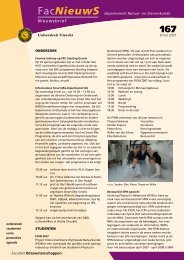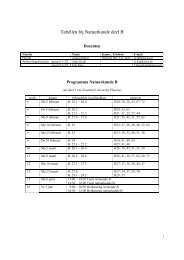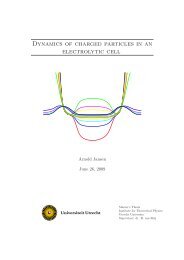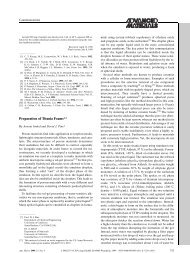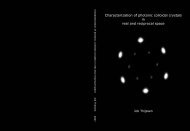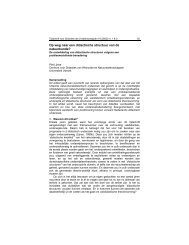Sedimentation Equilibrium of Mixtures of Charged Colloids
Sedimentation Equilibrium of Mixtures of Charged Colloids
Sedimentation Equilibrium of Mixtures of Charged Colloids
You also want an ePaper? Increase the reach of your titles
YUMPU automatically turns print PDFs into web optimized ePapers that Google loves.
Z 16=2993a0.6210 3 η iZ 11=2500.40.20150 200 250 300 350Z i1Z 14=27900 5 10 15 2010 3 η iX (cm)Figure 4.7: Example 1: Density pr<strong>of</strong>iles <strong>of</strong> a 21-component colloidal suspensionwith a Gaussian charge distribution as illustrated in the inset anddescribed by (4.15). The components have the same gravitational lengthsL i = 2mm.Example 2, figure 4.8, has the same charge distribution as example 1. Thegravitational length is scaled with the colloidal charge, L i ∝ Z − 3 2i . Thisexample describes a system with different particles, that have a constantmass and charge density, L i /σi 3 = L j /σj 3 resp. Z i /σi 2 = Z j /σj 2 . Except forthe gravitational lengths L i , the system is identical to example 1, to makethem comparable.The results <strong>of</strong> example 1 show layering <strong>of</strong> components, with the highestcharge on top. The results <strong>of</strong> example 2 do not show a layering. This canbe explained from the difference in mass per charge <strong>of</strong> the components. Inexample 1 the ratio isZ i L i= Z i, (4.16)Z j L j Z jwhereas in example 2√Z i L i Zj= . (4.17)Z j L j Z iTherefore, the variation <strong>of</strong> the mass per charge in example 2 is much smaller,as we can see in figure 4.8. The total packing fractions are very close to the26



